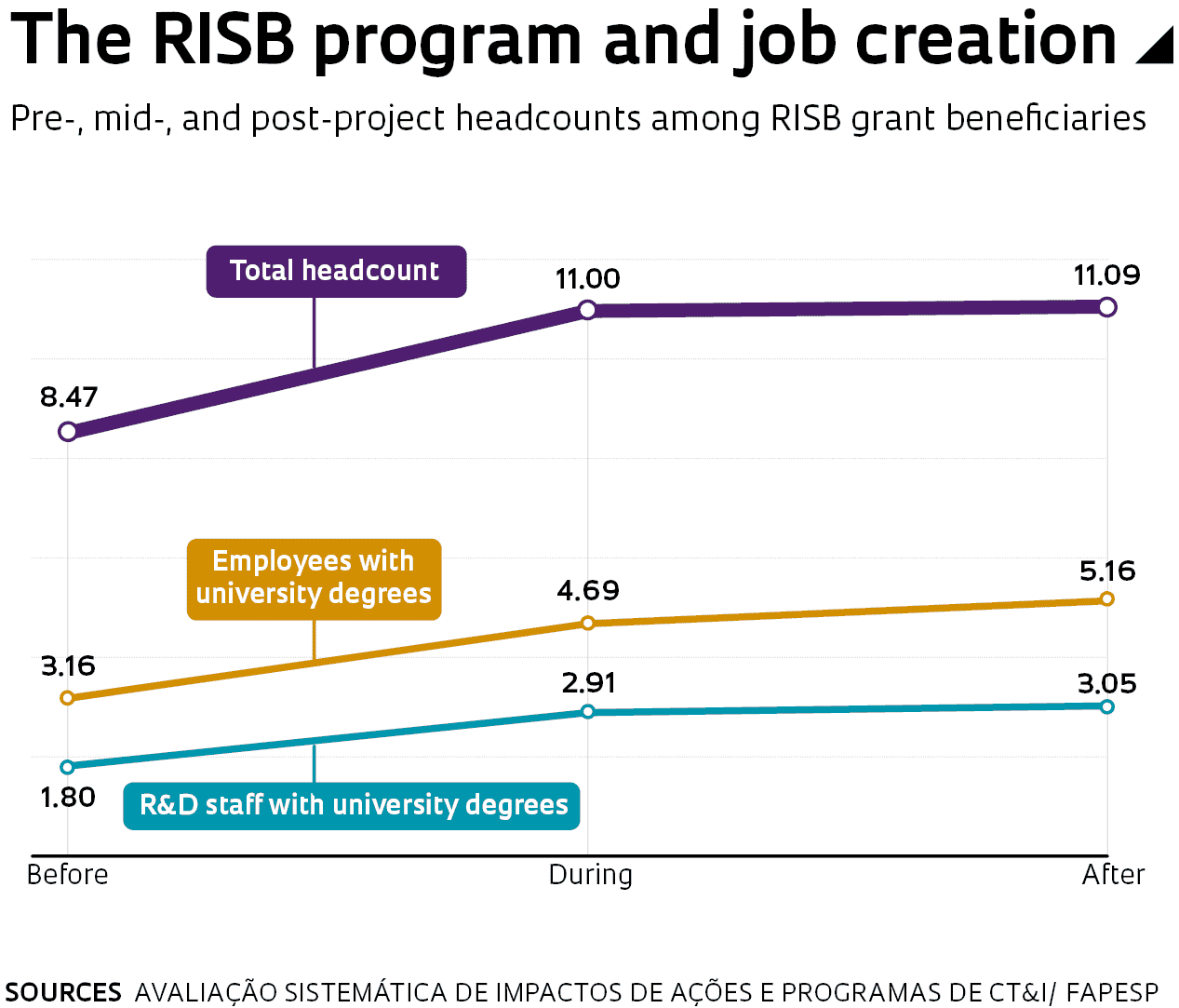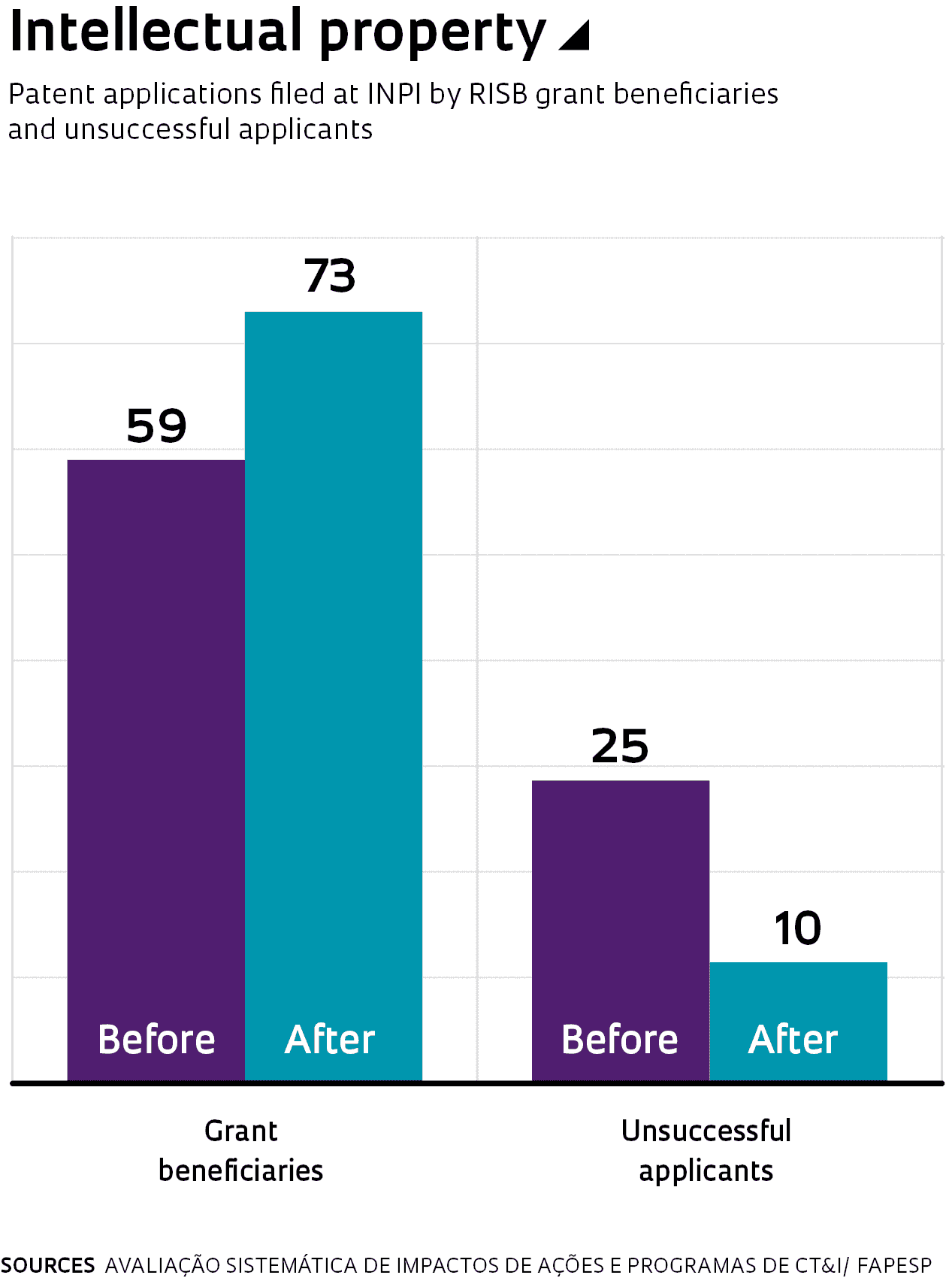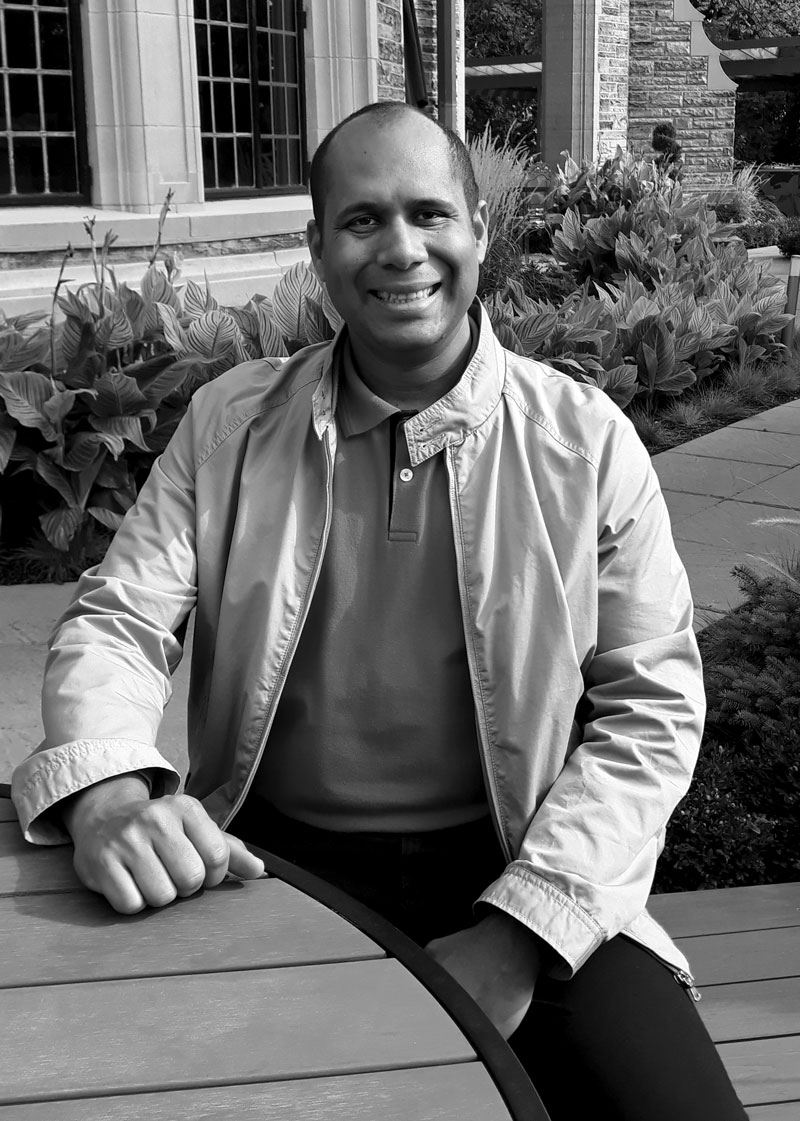A recent assessment to estimate impact from three FAPESP programs supporting small businesses, international collaborations, and training for new researchers found substantially positive outcomes. FAPESP’s Research for Innovation in Small Businesses program (RISB, or PIPE in the Portuguese acronym), for example, has benefited more than 1,500 tech startups and firms employing up to 250 people since the initiative was launched in 1997. The survey found that 80% of sampled firms’ grant projects successfully converted into innovation—as well as jobs. Program beneficiaries grew from an average of 8.5 employees each before launching grant projects to 11.1 after project completion.
In international research collaborations, papers published as part of FAPESP’s 230 collaborations with foreign institutions had a 96% greater impact, as measured by citations in the Scopus database, than research by non-FAPESP collaborations funded by the Foundation. Former doctoral fellows who received Foundation support had a six-times greater Scopus citation impact than non-fellows. For master’s fellows, the survey found a five times greater impact. “Many of the hypotheses we tested to gauge program effectiveness were confirmed, which shows that program goals are being met,” says Sérgio Salles-Filho, a coordinator at the University of Campinas (UNICAMP) Laboratory for Studies on the Organization of Research & Innovation (GEOPI), who led the assessment.
Data for the assessment was compiled from secondary sources such as resume and patent databases, quantitative and qualitative research indicators, data on employment and wages, and other sources. A quasi-experimental approach was taken to compare the performance of FAPESP-funded firms and researchers to their nonsupported counterparts, using statistical methods to approximate the attributes of treatment and control groups that were not directly comparable.

For the fellowship program, this method was used to assess the performance of three different groups. One group consisted of 12,600 former doctoral fellows, 15,800 master’s fellows, and 29,600 scientific initiation fellows who received Foundation fellowships between 2003 and 2017. The second group comprised 22,000 students in the same categories who were awarded fellowships from the Brazilian Federal Agency for Support and Evaluation of Graduate Education (CAPES) and the Brazilian National Council for Scientific and Technological Development (CNPq), after unsuccessfully applying for FAPESP fellowships. And the third group consisted of 7,400 master’s and doctoral students who completed graduate studies with no financial support after unsuccessfully applying for fellowships from the Foundation.
FAPESP fellows performed substantially better in areas such as scholarly publishing, citations, and national and international collaborations. They were also more likely to go on to pursue a career as a researcher. The most marked difference was observed in the sample of former doctoral fellows: FAPESP fellows published 21% more scientific papers than their CAPES and CNPq counterparts, and 113% more than non-fellows. “The data are compelling,” says Salles-Filho. “FAPESP fellowships correlate with a step improvement in citations among doctoral fellows—a five-time increase compared to non-fellows. Papers by former doctoral fellows received nine times as many mentions in social media, blogs, news websites and other media than papers by non-fellows. This provides a measure of the extent to which scientific research is meaningful outside of academia.”
The use of secondary data only created a number of limitations. One limitation was in cohort diversity. The survey was unable to compare FAPESP fellows to CNPq or CAPES fellows who had not previously applied for a FAPESP fellowship, or to students who had neither been awarded nor applied for FAPESP fellowships, which would have offered a larger universe for comparison. Another limitation was related to scientific initiation students: the number of students in the non-fellowship cohort was statistically insufficient for comparison against other groups.
Differences in performance might also be attributed to the training students received before applying for fellowships, as Brazilian funding agencies each use different criteria in their selection processes. FAPESP fellowship candidates are assessed by a panel of advisors and must have an outstanding academic record, in addition to a robust research proposal. Other agencies might award fellowships to meet affirmative action quotas at universities, which have a mandate to award them to graduate students at their discretion. “The beneficial effect from FAPESP’s stringent fellowship prerequisites and peer review practices is further reinforced by a requirement for fellows to submit research reports throughout their projects,” explains Salles-Filho. Under ideal circumstances, the assessment would have compared students with similar performance—for example, those who barely failed to qualify for FAPESP fellowships to borderline successful applicants—but students with these profiles could not be identified.

FAPESP fellows were more active than other groups in nearly all of the “hot” topics considered, especially in research on planets and galaxies, solar cells, and T-cell immunotherapy. Salles-Filho notes, however, that prominence indicators should be viewed with caution. There are some research topics in which Brazil has particular strengths, such as biofuels, but which are only prominent at a local level. This research will not rank as prominently at a global level, yet is vital for the country.
The assessment of international collaborations analyzed the scientific output of researchers supported by FAPESP from 1990 to 2018. The goal was to assess how research performance had evolved over time, especially since the mid-2000s, when the Foundation began to expand investment in international collaborations with foreign universities in a bid to further internationalize research programs in São Paulo. These collaborations, of which there are now more than 230, have helped to make research efforts more robust. Many involve large research programs that are designed and conducted jointly and on equal terms by researchers in Brazil and colleagues at foreign institutions. The first collaboration of this kind was established with the Research Councils UK (RCUK), followed by the German Research Foundation (DFG) and the National Science Foundation, in the US. In an interview published in April (see Pesquisa FAPESP issue no. 290), Carlos Henrique de Brito Cruz, then scientific director at FAPESP, explained how things had changed as a result: “We imported some of their procedures, such as how to organize meetings, what types of forms to use, and how to extract better and more detailed assessments from our advisors. Our system as a whole was improved.” The upshot is that from 2008 to 2018, the share of research projects as part of institutional collaborations rose from 0.12% to 9.77% of total grants.
The assessment covered all collaborations between researchers in São Paulo and international peers from 1990 to 2018. Research projects as part of collaborations set up by the Foundation (572 in all) were compared to collaborations established directly by researchers with grant funding from FAPESP, but without the institutional support of collaboration agreements (2,055). “The Foundation wanted to know whether research through FAPESP-mediated collaborations had greater impact than other research,” says Salles-Filho. Four hypotheses were tested, of which two were not confirmed: no difference was found between the two groups in terms of the raw number of papers published; nor were international collaborations found to be more prolific in developing technology. Other hypotheses, such as research impact, were confirmed by the data. “An analysis of Scopus data showed that research papers published within FAPESP collaborations were cited 96% more than those in the control group,” says Salles-Filho.
The assessment of the RISB program analyzed the performance of small businesses that had successfully applied for 185 grants between 2006 and 2016, compared to 296 businesses that had applied unsuccessfully. Firms that never applied were not included in the assessment. One of the most important benefits observed was job creation in R&D: grant awardees had twice as many researchers employed two years after completing their grant projects compared to the other group. Lead investigators in grant projects largely had post-doctoral (37%) and doctoral (35%) degrees. “The assessment showed that some of the most important goals of the program are being met, such as helping firms to build technical capabilities and expanding the number of employees involved in R&D, as well as supporting jobs,” says Sergio Queiroz, a professor in the Department of Science and Technology Policy at UNICAMP and deputy coordinator of Innovation Research on the Science Board at FAPESP.

The RISB program was, unlike the other programs, assessed using primary data due to the limited availability of small business databases in Brazil. The firms participating in the assessment answered an online questionnaire about their business and their innovation performance and investment. This data was then collated with data on intellectual property, employment, and other aspects. In more than 60% of cases, a causal relationship could be established between RISB grant support and the development of innovation.
“Our company simply wouldn’t exist without the program,” says engineer Antonio Massato Makiyama, a founding partner at Vivax, a company in São Caetano do Sul that now has 10 employees. “I had a promising idea, but without the support I received from the program I would not have been able to develop it into a prototype and a market-ready product,” says Makiyama, whose company has now developed five projects with RISB funding. In 2018, Vivax launched a portable robot that supports upper limb rehabilitation in people who have suffered a stroke. “I had worked at medical equipment companies when living in the US, and saw an opportunity to develop the product when I returned to Brazil,” he says. The robot costs US$80,000 and has now been purchased by 11 hospitals in Brazil. Makiyama is currently developing a similar robot for lower limb physical therapy.
As an important input from the assessment, four distinct groups of firms were identified among successful and unsuccessful applicants, whose different profiles provide insight into the dynamics of São Paulo’s innovation ecosystem. Two of the groups consisted of companies with the most rejected grant applications: one comprising firms with only average performance indicators, largely with no high-tech products, and the other comprising software developers with limited R&D investment.
The other two groups were composed largely of grant beneficiaries. The first consisted of well-established tech firms that invest in R&D and regularly collaborate with universities. In the second group were typical tech startups; firms in this group had a strong presence of female staff, and of lead investigators who had completed either doctoral degree programs or postdoctoral internships.
These two groups are each faced with very different challenges, explains Queiroz. Well-established firms often require support to overcome technical barriers, but the expertise they have acquired in the market enables them to build research teams themselves to tackle the problem. Startups are often strong in technical capabilities, but weak in business acumen. “We created the PIPE Empreendedor [RISB Entrepreneur] program to address this gap,” says Queiroz, referring to a training program for RISB grant beneficiaries to ensure their projects are commercially successful and sustainable.
Former fellows have produced award-winning theses

Personal archive
Biologist Andrew Thomas after completing doctoral work under a FAPESP fellowshipPersonal archiveSeveral former FAPESP fellows were among the winners of the 2019 CAPES Thesis Awards, which recognize outstanding research across 49 disciplines. Fabrícia Jordão, who has a PhD in visual arts from the University of São Paulo (USP) and is now a professor at the Federal University of Paraná, received an award for a thesis that explored the visual arts scene during Brazil’s political opening and transition to democracy (1974–1989). Her research showed that prominent artists such as Rubens Gerchman, Cildo Meireles, and Carlos Zilio kept communication channels open with government institutions even though they openly opposed the military regime. “Under the regime’s cultural policy, creating symbols and preserving cultural heritage was seen as strategic, and this provided artists with an opportunity to engage in experimental work,” she says. These artists, she found, were able to influence government policy without being co-opted by it. Her FAPESP fellowship allowed Jordão to travel the country to research archives in multiple cities. “I was able to show that local artists networked with each other the same way as in major cities.”
Another award recipient was mechanical engineer Danilo Beli, who is now pursuing a postdoctoral internship at USP’s School of Engineering in São Carlos. His award-winning thesis explored a subject that combined physics and engineering: phononic crystals and metamaterials that exhibit unusual behavior, such as negative refraction and band gaps—or frequencies at which wave propagation is prohibited. “These properties allow them to filter and manipulate waves and have applications in acoustics and vibration, like creating acoustic barriers or filters, sensors, and acoustic cloaking materials.” Midway into his doctoral studies, he took a sandwich internship at Georgia Tech, in the US, in a collaboration with Massimo Ruzzene. “Being exposed to research activity happening outside Brazil was especially useful,” he says. In São Carlos, Beli is now involved in a thematic project led by Carlos de Marqui Jr. that is studying phononic materials and metamaterials with applications in structural acoustics. Also participating in the project is his doctoral supervisor, José Roberto de França Arruda, a professor at the University of Campinas (UNICAMP) School of Mechanical Engineering.
Biologist Andrew Maltez Thomas received an award for a thesis investigating the relationship between gut bacteria and tumors. Using DNA sequencing and bioinformatics, he identified 16 bacteria in the human intestine that indicate the presence of colorectal cancer. His research could potentially lead to new methods of diagnosing the disease. “We used statistical and machine-learning approaches to analyze a large number of samples from around the world,” says Thomas. His interest in investigating the relationship between bacteria and cancer began during a master’s program in oncology, which he completed in 2012 at the A.C.Camargo Hospital Research Center under the supervision of Emmanuel Dias-Neto. His doctoral research in bioinformatics was supervised by João Carlos Setúbal, of the USP Institute of Chemistry, and co-supervised by Dias-Neto. During his research, he went for a sandwich internship at the University of Trento, in Italy, at a metagenomics lab under computer scientist Nicola Segata. Thomas is currently on a postdoctoral internship at the same laboratory, with funding from the European Union.

Personal archive
Chemist Flavio Kock after completing doctoral work under a FAPESP fellowshipPersonal archiveChemist Flávio Kock is on a FAPESP-funded postdoctoral internship at the University of Toronto, Canada. He won an award in the Chemistry category for a thesis on low-resolution nuclear magnetic resonance (LR-NMR) applications. His research at the USP Institute of Chemistry in São Carlos (IQSC), in a collaboration with EMBRAPA’s Instrumentation chapter and the Molecular Imaging Center at the University of Turin, in Italy, demonstrated how LR-NMR can be used to study molecules known as coordination compounds. He was able to conduct, for example, a rapid assessment of a new contrast agent that can interact with prostate tumor cells, potentially offering a new option to diagnose prostate cancer. Kock graduated and received his master’s degree from the Federal University of Espírito Santo. He conducted doctoral research with a fellowship from FAPESP under the supervision of Luiz Alberto Colnago from EMBRAPA. “The fellowship provided valuable support for high-level research in collaboration with the university in Italy, making an important contribution to a research program at IQSC in partnership with EMBRAPA,” he says.
Among the award recipients who are former FAPESP fellows is Iranian geologist Saeid Asadzadeh, who completed doctoral research at UNICAMP’s Institute of Geosciences (IG) and is currently doing postdoctoral research at the institution, again with funding from the Foundation. In 2013, Asadzadeh was looking for a university for his doctorate when a Canadian colleague of his recommended Carlos Roberto de Souza Filho, a professor at UNICAMP, to be his supervisor. “After doing some research about the professor’s previous work and the IG laboratories, I made my choice,” he says. He completed his first year of research under a CAPES fellowship, but was keen to apply for a FAPESP fellowship, which he did successfully in the second year. “My motivation was the prestige attached to a FAPESP fellowship.” In his research under Souza Filho, he developed a method of detecting hydrocarbons beneath the surface of the earth by analyzing remote sensing imagery. He credits the award to the impact his research has had in his field, including seven papers in some of the top geosciences journals. In his postdoctoral research, Asadzadeh is developing a method of analyzing the thermal properties of rocks to find evidence of oil using satellite imagery.

